Amazon is a vast marketplace, drawing in millions of customers with varying needs, preferences, budgets, and shopping mindsets. To aptly meet the needs of this diverse audience, providing a spectrum of product variations that match their distinct requirements is crucial.
In this blog post, we’ll delve into the significance of Amazon variation listings, what they entail, and step-by-step guidance on creating them effectively on the platform.
Understanding Amazon Variation Listing
Amazon variation listing allows sellers to consolidate various versions of a product on Amazon’s platform. Rather than listing each version individually, such as different colors or sizes, they can centralize them under one primary listing.
Here’s the process:
Imagine you’re selling a t-shirt available in five colors and three sizes.
Rather than creating eight different listings for every color and size permutation, you can establish a single listing for multiple t-shirt variations. Within this listing, customers can select their preferred color and size from dropdown menus or buttons.
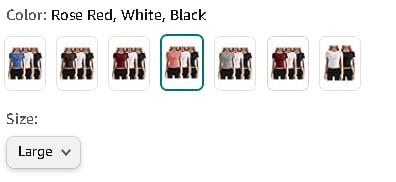
This setup benefits both sellers and customers. Sellers avoid the hassle of juggling multiple listings for the same product, saving time and simplifying inventory management. Customers conveniently view all available options for their desired product without the need to browse through various listings.
Variation listings streamline the purchasing journey as customers can review all available options in one location and make selections without leaving the main product page.
In the end, it’s a win-win scenario for both sellers and shoppers on Amazon.
Structure of an Amazon Variation Listing
The structure of an Amazon Variation Listing is straightforward, following a Parent-Child Relationship, also known as a Parent-Child Listing. This structure typically involves three main components: Parent, Child, and Variation Theme. Let’s explore each of these in detail.
1. What is a Parent Listing?
A parent listing is a category that encompasses all variations of a product. It functions as a grouping mechanism, where items of the same type with different qualities and features are found together.
Customers cannot purchase the parent listing itself; instead, it connects or organizes the variations on a single page.
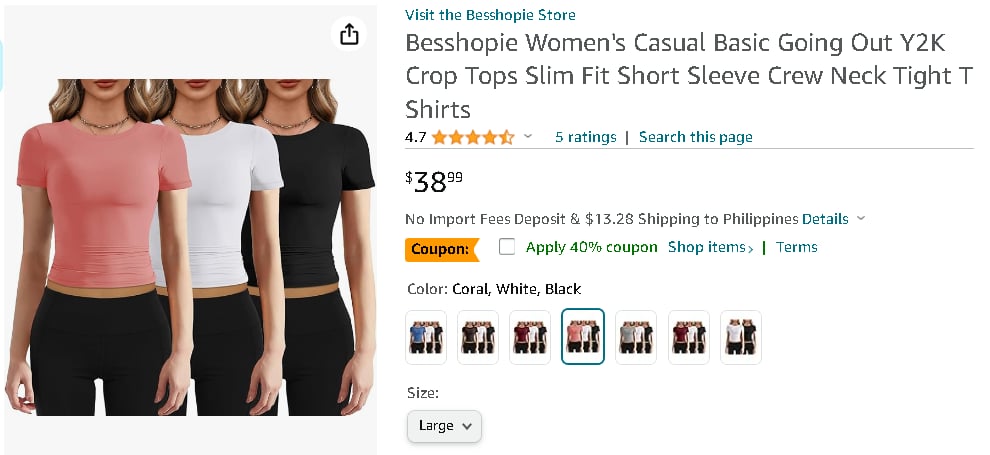
2. What are Child Listings?
Child listings represent the specific variations of the parent product, such as different colors or sizes. Each child listing corresponds to a particular variant, enabling customers to choose their preferred option. These variations are showcased on the same product page as the parent, facilitating easy customer selection.
For example, if the parent listing features a t-shirt available in various colors like red, blue, and green, each color option would be presented as a child listing.
3. What are Variation Themes?
The Variation theme determines the attribute or dimension by which the variations are grouped. It outlines the distinct characteristics that set the child listings apart from one another, aiding customers in navigating options and choosing the variant that aligns with their preferences.
Common variation themes include:
Size: Relevant for clothing, shoes, and similar items.
Color: Applicable across various product categories.
Style: Pertinent to design or model differences.
Pattern: Variations featuring diverse prints or textures.
Flavor: Associated with consumable products.
Quantity: Relevant for products sold in varying package quantities.
What are the Benefits of Using Amazon Variation Listing?
Amazon variation listings provide numerous advantages for sellers seeking to streamline product management and enhance their sales strategies. Here’s an in-depth breakdown of these benefits:
1. Engaging Customers
The primary benefit of employing variation listings is heightened customer engagement. Consider the following scenario:
Picture a customer in search of a particular type of shoe. Through variations, they can explore all available color and size options on a single product page.
This eradicates the necessity to hunt through separate listings, thereby maintaining their engagement and directing their attention toward your brand’s offerings.
It’s akin to having a virtual showroom where customers can delve into all possibilities without departing from your product.
2. Increased Conversion Rates
By streamlining the purchasing process, variations can greatly enhance the probability of a customer finalizing a purchase. Consider encountering two comparable products: one with variations and one with individual listings. The option with variations enables effortless comparison of sizes or colors, simplifying and expediting the decision-making process. This smooth experience directly correlates to increased conversion rates for you.
3. Combined Reviews
Variations combine reviews from all child products within the parent listing, providing a comprehensive feedback pool for potential customers. A greater volume of reviews, particularly positive ones, establishes trust and credibility for your brand, significantly impacting purchasing decisions.
4. Increased Organic Ranking
Amazon’s search algorithms prioritize listings that offer higher perceived value to customers. Variation listings present a broader selection within a product category, enhancing relevance to a wider array of searches. Moreover, the combined reviews under a variation listing can lead to a stronger overall rating, which further boosts search ranking.
5. Boost in Sales
The combined impact of enhanced customer engagement, higher conversion rates, and improved visibility in search rankings leads to a potential surge in sales. By providing a wider selection within a single listing, you cater to a larger audience, making it easier for customers to find exactly what they’re looking for.
This results in more sales and a stronger presence on the Amazon marketplace.
How to Create an Amazon Variation Listing
Understanding how to create an Amazon variation listing is essential once you realize its importance. Here’s a step-by-step guide:
Step 1: Log into your Seller Central account. Go to the Inventory Tab to start creating your Amazon listing variation.
Step 2: In the Inventory Tab, select “Add A Product” and choose the option “I’m adding a product that is not sold on Amazon.”
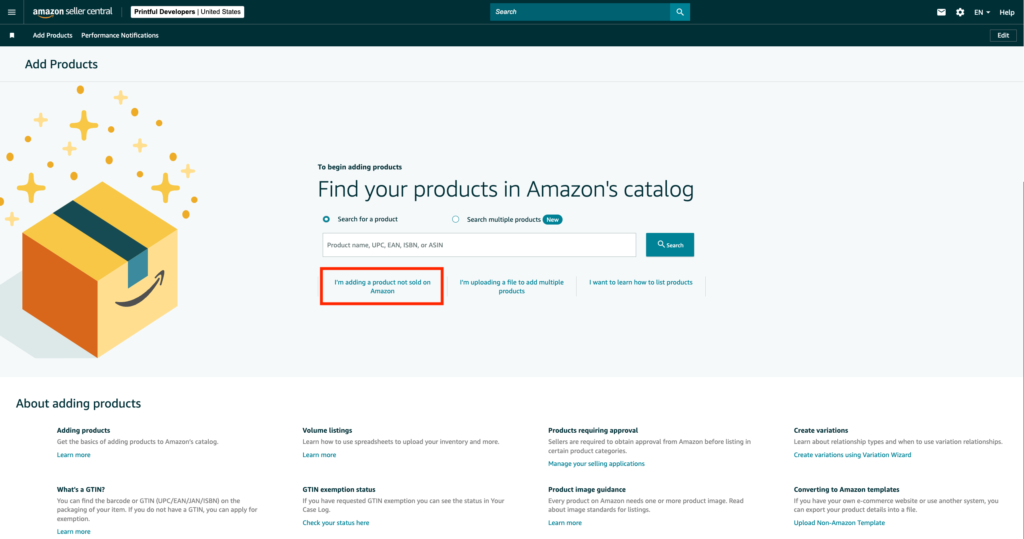
Step 3: Name your product and choose the category that best matches your items.
Step 4: On the following page, provide additional details about your product, including the brand name, product ID, and any variations. If your product has variations, select ‘Yes’ next to “Does the product have variations?” Complete the remaining required information and click Next to proceed.
Step 5: Go to the Variations tab. Select the type of variation your product offers and list all available variations.
Step 6: Enter specific details for each variation, such as product ID, product type, condition, price, quantity, etc. Ensure all necessary information is provided for each variation you’ve created.
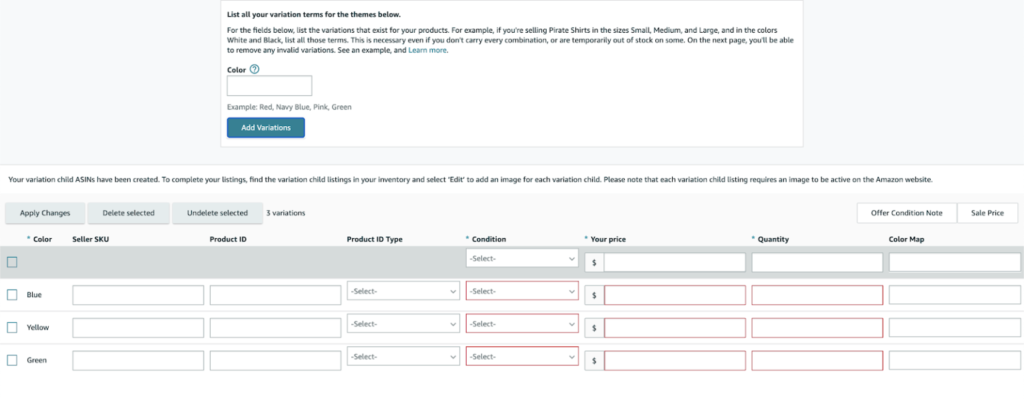
Step 7: After adding all variations and completing the listing, submit it for review.
How to Add Variations to an Existing Amazon Listing
Incorporating variations into an existing Amazon listing is straightforward and swift. Here are the steps to follow:
Step 1: Sign in to your Seller Central account and navigate to the inventory tab.
Step 2: Under the inventory tab, choose “Manage Inventory” to access all your listings. Select the listing you wish to augment with variations.
Step 3: Once you’ve chosen the product or parent listing, click on the “Edit” option situated at the right end of the listing.
Step 4: Clicking on “Edit” will take you to the product details page, which contains various tabs. Proceed to the “Variations” tab.
Step 5: Within the variations tab, begin by choosing the variation theme or attributes you wish to employ. Select one attribute at a time.
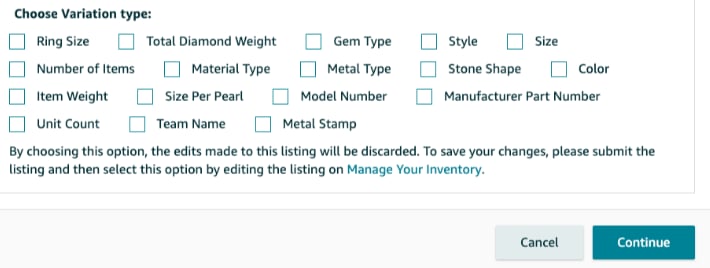
Step 6: After selecting the attribute or variation theme, proceed to create variations based on that selection. For example, if color is the chosen attribute, add multiple colors as variations.

Step 7: For each variation, input details such as product ID, type, condition, price, and quantity. If you’re using ASIN, ensure to enter the parent ASIN in the product ID field. For example, if you’ve created variations for red, blue, and green, fill in all the necessary details for each variation.
Step 8: Once you’ve filled in the details for every variation, click on “Save and Finish.” Your existing listing will now become an Amazon Variation Listing, including all the variations you’ve created.
Amazon Variation Listing Tips
The Amazon Variation Listing feature is an incredible tool available for free, and when utilized effectively by sellers, it can lead to significant sales, increased customer engagement, and more. Here are some essential tips for optimizing Amazon Variation Listings:
1. Verify if your product category supports variations during listing creation or consult Amazon’s category-specific templates.
2. Ensure the parent listing highlights the core features of the product, accompanied by high-quality images representing all variations.
3. Maintain consistency by using specific and identical images for each product variation, aiding customers in easy classification.
4. Employ accurate and consistent terms for each variation theme (e.g., size, color) to enhance customer understanding.
5. Monitor sales performance of different variations and adjust pricing or promotions accordingly.
6. Incorporate relevant keywords and terms that align with how customers search for your variations.
7. Consider leveraging A+ Content to present variations in a visually appealing manner and provide additional product information, potentially boosting sales.
Final Thoughts
To wrap it up, crafting variation listings can greatly boost your product’s visibility and customer satisfaction. By adhering to the steps laid out in this blog, you can develop compelling variations that highlight the distinctive features of your products.
Whether you’re initiating a new listing or integrating variations into an established product, dedicating effort to optimize your variations can substantially enhance your Amazon performance.
Written By: Ayessa Camantigue

Email: [email protected]
Website: www.ehpconsultinggroup.com
Phone: (813) 733-6304
Date Written: June 4, 2024
